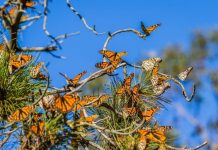Do you have any idea what do monarch butterflies eat? The monarch butterfly (Danaus plexippus) is probably the most familiar butterfly species throughout the North America. Researchers also name them monarchs. They are also known as common tiger and wanderer. The name wanderer possibly derives from their ability to migrate long distances. Monarchs are the members of the subfamily Danainae. All 157 members of Danainae are known as milkweed butterflies precisely because the larva of such species feed exclusively on hostplants of milkweeds. Now let us study what do monarch butterflies eat besides milkweed.
What Do Monarch Butterflies Eat and Drink?
Like most other butterflies monarch butterflies are also herbivores. They have a varied diet in that the young eats leaves of milkweed plant while the adults feed on nectar of flowers. Monarchs use their hollow tongue to suck liquid from the flowers.
Nectar is a highly nutritious food source. A butterfly stores the nectar as a fat or lipid in her body in preparation for the migration.
They use tongue just like we use straws in drinking. While researchers are not sure as to what time the monarchs are the most active they do however observe many monarchs feeding on nectar during midday hours. Nectar is an extremely nutritious food source. A butterfly stores the nectar as a fat or lipid in her body in preparation for the migration.
What Plants Do Monarch Butterflies Eat?
Adult monarchs likely feed on a range of different plants including thistles, Indian hemp, wild carrot, coneflowers, milkweeds, spotted Joe-Pye weed, teasel, asters, goldenrod, blazing stars, common boneset, horseweed, blazing stars, lilac, dame’s rocket, alfalfa, tail ironweed, and red clover.
Adult monarchs likely feed on a range of different plants including thistles, Indian hemp, wild carrot, coneflowers, milkweeds, spotted Joe-Pye weed, teasel, asters, goldenrod, blazing stars, common boneset…
Monarchs feed on a range of different hostplants and nectar. The caterpillar feeds on numerous milkweeds such as desert milkweed, California milkweed, woolly pod milkweed, Arizona milkweed, antelope horns milkweed, heartleaf milkweed, sandhill/pinewoods milkweed, swamp milkweed, Mexican whorled milkweed, aquatic milkweed, Caribbean milkweed, showy milkweed, butterfly weed, rush milkweed, showy milkweed, white vine, crown flower, whorled milkweed, white milkweed, sand vine milkweed, woolly milkweed, and green antelopehorn milkweed.
What Flowers Do Monarch Butterflies Eat?
Monarchs are thought to feed on a butterfly flower (Asclepias syriaca) which is also known as common milkweed or silky swallow-wort. While larvae feed almost exclusively on milkweeds adult monarchs feed on nectar bearing flowers. They are most likely to feed on a range of different flowers.
Monarchs require a great deal of energy especially in migratory seasons. Most monarchs drink enough nectar which would build up fat reserves. They do not only drink nectar to fly great distances—monarchs rely on nectar to go by winter months. Over-wintering monarchs are least likely to feed on nectar.
For those which are living in the eastern North America, they typically migrate to Texas in spring—leaving the over-wintering locations. Before they begin their journey, they feed on wildflowers’ nectar which also helps them in developing reproductive organs.
Do Monarch Butterfly Caterpillars Eat Parsley?
No the monarch butterfly caterpillar never eats parsley and if they ever try to eat one they would not survive at all. Black swallowtail caterpillars however regularly feed on parsley but they do not consume milkweed plants just like the monarchs do.
Monarch caterpillars are the ones suited to eating milkweeds. They usually chew the leaf edges farthest from the stem. Monarch’s bodies are also quite resistant to the chemical compounds however they must fly to expend energy to prevent being poisoned.
Do Monarch Butterfly Caterpillars Eat each other?
In a series of research studies the monarch butterfly caterpillars show a cannibalistic behavior. At times when the food is scarce the monarchs become so opportunistic that they eat each other.
References
Forest Service, United States; Monarch Butterfly: North America’s migrating insect, U.S. Dept. of Agriculture, Forest Service, 2008 – Nature.
Frick-Ruppert Jennifer: Mountain Nature: A Seasonal Natural History of the Southern Appalachians; Univ of North Carolina Press, 15-Apr-2010 –Nature.


